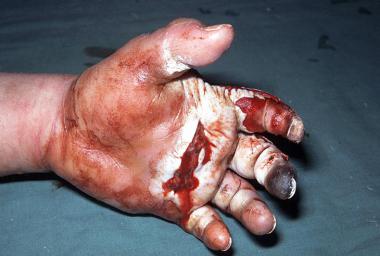

In 1937, Rees published a case of a high-pressure injection (HPI) injury to the finger. This injury involved diesel fuel.[1] Prior to Rees’s report, Hesse had described a similar injury in 1925.[2]
HPI injuries involving grease and paint are considered surgical emergencies, whereas HPI injuries with other substances require careful clinical evaluation and/or surgical intervention. Clean water and air injuries may result in good functional outcomes with simple monitoring and conservative management (see Treatment). Generally, surgeons should have a low threshold for surgical management of HPI injuries.
For patient education materials, see the Hand, Wrist, Elbow, and Shoulder Center, as well as Finger Injuries, Hand Injuries, and Puncture Wound.
NextHigh-pressure guns emit jet streams at pressures of thousands of pounds per square inch (psi). At these extreme pressures, material is forced through the skin, where diffusion can occur along fascial planes, tendon sheaths, and neurovascular bundles.[3]
Various mechanisms can be used to explain the clinical picture of HPI injuries. Ischemia, necrosis from high-velocity mechanical impact, the direct toxic effect of the involved chemical, and infection play major roles in these types of injuries.[4, 5, 6, 7] Factors contributing to digital ischemia include massive vessel thrombosis from volatilization of the injected material, temporary vascular spasm as a response to trauma, venous outflow obstruction from tissue distention, and digital artery compression.[8] The volume of material injected into a closed space and the resultant edema can exacerbate ischemia.[9]
The chemical properties of the injected material have a considerable effect on clinical injury. With viscous substances, such as grease and oil-based compounds, dispersion is less marked than it is with more fluid materials. These substances tend not to penetrate the flexor sheath, resulting in infiltration of the surrounding neurovascular bundles. Low-viscosity solvents, such as paint thinners, may disperse more readily into the soft tissues. Injection pressure is also reported to be a factor in the extent of injury.[10]
Some have suggested that the predominant mechanism of tissue damage is chemical irritation and that this is more important than ischemia. Ramos et al concluded that an injection of isotonic sodium chloride solution under high pressure into tissue does not produce a significant inflammatory reaction.[7, 11] Clinically, Pai et al noted that injected water did not induce extensive soft-tissue destruction, even when the injury was treated conservatively.[12]
Paint thinners lead to more extensive damage and may cause lipid dissolution and destruction of tissues, even when not injected under high pressure.[5, 13] Also, paints and paint thinners produce the most severe inflammatory responses, leading to high amputation rates.[3, 14] Grease has been shown to be associated with oleogranulomata formation (a reaction to foreign bodies), fistula formation, fibrosis, and poor functional outcomes.[6, 13, 15] Joint contractures and ankylosis are also seen.[16]
Common substances involved in HPI injuries include grease, which accounts for 57% of injuries (at pressures of up to 5000-10,000 psi), paint (up to 5,000 psi; see the image below), and diesel fuel (accounting for 14% of injuries, with pressures of up to 2000-6000 psi).[16, 17, 18] In a 1970 report, Kaufman compared the kinetic energy from a grease gun to a 1000-kg weight falling from a height of 25 cm.[4] Injuries with compressed air (at pressures of up to 50-300 psi) and high-pressure water injection (up to 6000-8000 psi) are also seen.[19, 20, 10, 21, 22, 23, 24] HPI injuries continue to be caused by an increasing number of substances, including paint, wax, molten metal, air, water, paint thinner, and other solvents.[25, 26]
 Photograph taken approximately 12 hours after a high-pressure injection injury involving paint.
Photograph taken approximately 12 hours after a high-pressure injection injury involving paint.
Although more than 100 case reports of HPI injuries of the hand can be found in the literature, the incidence is difficult to assess. Nonetheless, a group from the University of Colorado described an estimated incidence of 1 in 600 hand injuries seen in their emergency department.[16] These numbers suggest that HPI injuries to the hand are relatively common, given the widespread use of pressure machinery.
HPI injuries often manifest as innocuous lesions on the fingertip of a patient's nondominant hand. Depending on the substance involved, these injuries may follow a benign clinical course (for air and clean water) or may be deceptively destructive and lead to soft-tissue necrosis and amputation (for grease and paint).
Proper triage and management of HPI injuries of the hand is imperative; the attending physician should recognize grease and paint injuries as surgical emergencies. A delay in treatment may result in inferior functional outcomes.[5, 27] In the digits, amputation rates are as high as 48%.[16, 5, 11]
Overall, HPI injuries result in significant impairment of function and reintegration into the work force, as well as aesthetic deformity. The most common long-term impairments include cold intolerance and hypersensitivity; however, grip strength, pinch, range of motion, and two-point discrimination are also affected.[28, 29, 30]
Clinical Presentation
Copyright © www.orthopaedics.win Bone Health All Rights Reserved